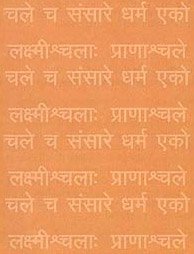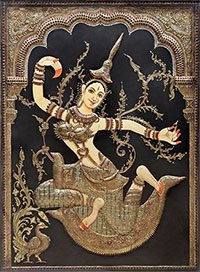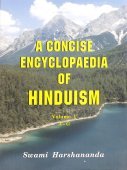Aranyaka, Āraṇyaka, Araṇyaka: 20 definitions
Introduction:
Aranyaka means something in Buddhism, Pali, Hinduism, Sanskrit, the history of ancient India, Marathi. If you want to know the exact meaning, history, etymology or English translation of this term then check out the descriptions on this page. Add your comment or reference to a book if you want to contribute to this summary article.
In Hinduism
Mīmāṃsā (school of philosophy)
Source: Srimatham: Mīmāṃsa: The Study of Hindu ExegesisĀraṇyaka (आरण्यक) refers to the third section of Vedic literature.—The Brāhmaṇas and Āraṇyakas are ritual texts based upon the practical application and usage of the Saṃhita portion in rituals (yajñas).

Mimamsa (मीमांसा, mīmāṃsā) refers to one of the six orthodox Hindu schools of philosophy, emphasizing the nature of dharma and the philosophy of language. The literature in this school is also known for its in-depth study of ritual actions and social duties.
Ayurveda (science of life)
Nighantu (Synonyms and Characteristics of Drugs and technical terms)
Source: Wisdom Library: Raj NighantuAraṇyaka (अरण्यक) or Araṇyakavarga is another name for Śālmalyādi: the eighth chapter of the 13th-century Raj Nighantu or Rājanighaṇṭu (an Ayurvedic encyclopedia). The Rāja-nighaṇṭu is a medical lexicon ascribed originally known as the Abhidhānacuṇāmaṇi. It mentions the names of 1483 medicinal drugs (auṣadhi) and substances (dravya) excluding synonyms, grouped into twenty-two chapters [viz., Araṇyaka-varga].

Āyurveda (आयुर्वेद, ayurveda) is a branch of Indian science dealing with medicine, herbalism, taxology, anatomy, surgery, alchemy and related topics. Traditional practice of Āyurveda in ancient India dates back to at least the first millenium BC. Literature is commonly written in Sanskrit using various poetic metres.
Sports, Arts and Entertainment (wordly enjoyments)
Source: archive.org: Syainika Sastra of Rudradeva with English Translation (art)Āraṇyaka (आरण्यक) refers to “wild birds”, according to the Śyainika-śāstra: a Sanskrit treatise dealing with the divisions and benefits of Hunting and Hawking, written by Rājā Rudradeva (or Candradeva) in possibly the 13th century.—Accordingly, “[...] Why hawking (śyenapātā) is hunting? Is it following the hent of the birds’ inclination or that of others? If you say it is according to the inclination of the wild birds (āraṇyaka) themselves, in that case the term mṛgayā or hunting would be meaningless [svairamāraṇyakānāṃ cet mṛgavyeti nirarthakam]. If you say the term is applicable, as the hare-hawk captures animals, then why not apply it in the case of lions and others catching their prey? [...]”.

This section covers the skills and profiencies of the Kalas (“performing arts”) and Shastras (“sciences”) involving ancient Indian traditions of sports, games, arts, entertainment, love-making and other means of wordly enjoyments. Traditionally these topics were dealt with in Sanskrit treatises explaing the philosophy and the justification of enjoying the pleasures of the senses.
General definition (in Hinduism)
Source: WikiPedia: HinduismĀraṇyaka (आरण्यक): Part of the Hindu Śruti that discuss philosophy, sacrifice and the New Year holiday.
In Buddhism
General definition (in Buddhism)
Source: Wisdom Library: Dharma-samgrahaĀraṇyaka (आरण्यक) refers to “the virtue of (living in a) wilderness” and represents one of the “twelve ascetic virtues” (dhūtaguṇa) as defined in the Dharma-saṃgraha (section 63). The Dharma-samgraha (Dharmasangraha) is an extensive glossary of Buddhist technical terms in Sanskrit (e.g., āraṇyaka). The work is attributed to Nagarjuna who lived around the 2nd century A.D.
India history and geography
Source: Cologne Digital Sanskrit Dictionaries: Indian Epigraphical GlossaryĀraṇyaka.—(LL), a Buddhist hermit. Note: āraṇyaka is defined in the “Indian epigraphical glossary” as it can be found on ancient inscriptions commonly written in Sanskrit, Prakrit or Dravidian languages.

The history of India traces the identification of countries, villages, towns and other regions of India, as well as mythology, zoology, royal dynasties, rulers, tribes, local festivities and traditions and regional languages. Ancient India enjoyed religious freedom and encourages the path of Dharma, a concept common to Buddhism, Hinduism, and Jainism.
Languages of India and abroad
Marathi-English dictionary
Source: DDSA: The Aryabhusan school dictionary, Marathi-Englishāraṇyaka (आरण्यक).—a Belonging to the desert, wild.
Marathi is an Indo-European language having over 70 million native speakers people in (predominantly) Maharashtra India. Marathi, like many other Indo-Aryan languages, evolved from early forms of Prakrit, which itself is a subset of Sanskrit, one of the most ancient languages of the world.
Sanskrit dictionary
Source: DDSA: The practical Sanskrit-English dictionaryAraṇyaka (अरण्यक).—
1) Forest-court.
2) Name of a plant (Mar. bakāṇā niṃba).
Derivable forms: araṇyakam (अरण्यकम्).
--- OR ---
Āraṇyaka (आरण्यक).—a. [araṇye bhavaḥ vuñ] Relating to or produced in a forest, wild, forest-born (usually with the words adhyāya, manuṣya, nyāya, pathin, vihāra, and hastin P.IV.2.129 Vārt.)
-kaḥ A forester, an inhabitant of the woods; तपः षड्भागमक्षय्यं ददत्यारण्यका हि नः (tapaḥ ṣaḍbhāgamakṣayyaṃ dadatyāraṇyakā hi naḥ) Ś.2.14; द्वावप्यत्रारण्यकौ (dvāvapyatrāraṇyakau) Ś.5. आरण्यकोपात्तफलप्रसूतिः (āraṇyakopāttaphalaprasūtiḥ) R.5.15.
-kam An Āraṇyaka; it is one of a class of religious and philosophical writings (connected with the Brāhmaṇas) which are either composed in forests, or must be studied there; e. g. ऐतरेयारण्यकम् (aitareyāraṇyakam); बृहदारण्यकम् (bṛhadāraṇyakam) and तैत्तिरीया- रण्यकम् (taittirīyā- raṇyakam); अरण्येऽनूच्यमानत्वात् आरण्यकम् (araṇye'nūcyamānatvāt āraṇyakam), Bṛ. Ar. Up.; (araṇye'- dhyayanādeva āraṇyakamudāhṛtam); वेदवादानतिक्रम्य शास्त्राण्यारण्यकानि च (vedavādānatikramya śāstrāṇyāraṇyakāni ca) Mahābhārata (Bombay) 12.19.17.
Source: Cologne Digital Sanskrit Dictionaries: Edgerton Buddhist Hybrid Sanskrit DictionaryAraṇyaka (अरण्यक).—m. (= Pali araññaka), = ār°, one of the dhūtaguṇa: Divyāvadāna 141.21.
--- OR ---
Āraṇyaka (आरण्यक).—m. (Sanskrit id., forest dweller, not in technical sense; = Pali āraññaka, also ara° in both [Buddhist Hybrid Sanskrit] and Pali), dwelling in the forest, one of the dhūtaguṇa: Mahāvyutpatti 1134; Dharmasaṃgraha 63; Aṣṭasāhasrikā-prajñāpāramitā 387.3; Mūla-Sarvāstivāda-Vinaya iii.122.4.
Source: Cologne Digital Sanskrit Dictionaries: Shabda-Sagara Sanskrit-English DictionaryĀraṇyaka (आरण्यक).—mfn.
(-kaḥ-kā-kaṃ) Forest, wild, forest-born or produced. m.
(-kaḥ) A forester, an inhabitant of the woods. E. āraṇya and kan added.
Source: Cologne Digital Sanskrit Dictionaries: Benfey Sanskrit-English DictionaryAraṇyaka (अरण्यक).—[araṇya + ka], n. A forest, Yājñ, 3, 192.
--- OR ---
Āraṇyaka (आरण्यक).—[āraṇya + ka], I. adj. Referring to forests, Mahābhārata 15, 532; produced in forests, [Rāmāyaṇa] 2, 36, 6. Ii. m. An anchorite, [Śākuntala, (ed. Böhtlingk.)] [distich] 46. Iii. n. The name of a book, [Mānavadharmaśāstra] 4, 123.
Source: Cologne Digital Sanskrit Dictionaries: Cappeller Sanskrit-English DictionaryĀraṇyaka (आरण्यक).—[adjective] = [preceding] [adjective]; [masculine] forester, hermit; [neuter] a class of religious writings to be studied in the forest.
Source: Cologne Digital Sanskrit Dictionaries: Aufrecht Catalogus CatalogorumĀraṇyaka (आरण्यक) as mentioned in Aufrecht’s Catalogus Catalogorum:—See Aitareyaº, Kauṣītakiº, Taittirīyaº, Bṛhadāraṇyaka.
Source: Cologne Digital Sanskrit Dictionaries: Monier-Williams Sanskrit-English Dictionary1) Araṇyaka (अरण्यक):—[from araṇya] n. a forest, [Yājñavalkya iii, 192], the plant Melia Sempervirens, [cf. Lexicographers, esp. such as amarasiṃha, halāyudha, hemacandra, etc.]
2) Āraṇyaka (आरण्यक):—[from āraṇya] mfn. forest, wild, forest-born, produced in a forest, relating to a forest or a forest animal, (the āraṇyakam parva of the Mahā-bhārata is either the whole third book or only the first section of it)
3) [v.s. ...] m. a forester, an inhabitant of the woods, [Mahābhārata; Raghuvaṃśa etc.]
4) [v.s. ...] n. Name of a class of religious and philosophical writings closely connected with the Brāhmaṇas and called Āraṇyakas because either composed in forests or studied there, (the Upaniṣads are considered to be attached to them.)
Source: Cologne Digital Sanskrit Dictionaries: Yates Sanskrit-English DictionaryĀraṇyaka (आरण्यक):—(kaḥ) 1. m. A forester. a. Wild, produced in the woods.
Source: DDSA: Paia-sadda-mahannavo; a comprehensive Prakrit Hindi dictionary (S)Āraṇyaka (आरण्यक) in the Sanskrit language is related to the Prakrit words: Araṇṇaya, Āraṇṇaga, Āraṇṇaya.
[Sanskrit to German]
Sanskrit, also spelled संस्कृतम् (saṃskṛtam), is an ancient language of India commonly seen as the grandmother of the Indo-European language family (even English!). Closely allied with Prakrit and Pali, Sanskrit is more exhaustive in both grammar and terms and has the most extensive collection of literature in the world, greatly surpassing its sister-languages Greek and Latin.
Kannada-English dictionary
Source: Alar: Kannada-English corpusĀraṇyaka (ಆರಣ್ಯಕ):—[adjective] = ಆರಣ್ಯ [aranya]1.
--- OR ---
Āraṇyaka (ಆರಣ್ಯಕ):—
1) [noun] one who lives in a forest; a forest-dweller.
2) [noun] that part of the Vēdas relating to Brāhmaṇa dealing mainly with the cosmic significance of the Vedic rituals and also contain mythological, legendary materials.
Kannada is a Dravidian language (as opposed to the Indo-European language family) mainly spoken in the southwestern region of India.
Nepali dictionary
Source: unoes: Nepali-English DictionaryĀraṇyaka (आरण्यक):—adj. relating to/produced in forest; wild; forest born; n. 1. a forester; an inhabitanto of the woods; 2. an Aranyaks (one of the religious and philosophical writings);
Nepali is the primary language of the Nepalese people counting almost 20 million native speakers. The country of Nepal is situated in the Himalaya mountain range to the north of India.
See also (Relevant definitions)
Starts with: Aranyakadali, Aranyakagana, Aranyakaka, Aranyakakanda, Aranyakam, Aranyakana, Aranyakanda, Aranyakarpasi, Aranyakarppasi, Aranyakashiksha, Aranyakavarga, Aranyakopanishad.
Ends with: Aitareyaranyaka, Brihadaranyaka, Caturtharanyaka, Kaushitakaranyaka, Kaushitakyaranyaka, Sa-padra-aranyaka, Saranyaka, Sarvaranyaka, Shankhayanaranyaka, Shaunakaranyaka, Taittiriyaranyaka, Yajuraranyaka, Yajurvedaranyaka.
Full-text (+748): Badhva, Aranyakam, Aruneyapada, Taittiriyaranyaka, Aitareyaranyaka, Sa-padra-aranyaka, Ugradeva, Saranyaka, Aitareya, Aranyakavarga, Aranyakagana, Brahmana, Svara, Brihadaranyakavyakhya, Brihadaranyakabhashyatika, Brihadaranyakabhashya, Brihadaranyakaviveka, Brihadaranyakabhashyavarttika, Brihadaranyakavarttikasara, Brihadaranyakavishayanirnaya.
Relevant text
Search found 106 books and stories containing Aranyaka, Āraṇyaka, Araṇyaka; (plurals include: Aranyakas, Āraṇyakas, Araṇyakas). You can also click to the full overview containing English textual excerpts. Below are direct links for the most relevant articles:
Asvalayana-grihya-sutra (by Hermann Oldenberg)
Rivers in Ancient India (study) (by Archana Sarma)
Introduction to Āraṇyaka and Upaniṣad Literature < [Chapter 4 - The Rivers in the Āraṇyaka and Upaniṣadic Literature]
1. The rivers in the Āraṇyakas < [Chapter 4 - The Rivers in the Āraṇyaka and Upaniṣadic Literature]
1. The Vedic Literature < [Chapter 1 - Introduction]
Atithi or Guest Reception (study) (by Sarika. P.)
Part 3 - Atithi-saparyā in Āraṇyakas < [Chapter 2 - Ātithyeṣṭi]
Treatment of Atithi in Vedas < [Chapter 2 - Ātithyeṣṭi]
Part 2 - Pañcamahāyajñas (The five daily great observances) < [Chapter 7 - Pañcamahāyajñas]
A History of Indian Philosophy Volume 1 (by Surendranath Dasgupta)
Part 6 - The Āraṇyakas < [Chapter II - The Vedas, Brāhmaṇas And Their Philosophy]
Part 1 - The place of the Upaniṣads in Vedic literature < [Chapter III - The Earlier Upaniṣads (700 B.c.— 600 B.c.)]
Part 3 - Brāhmaṇas and the Early Upaniṣads < [Chapter III - The Earlier Upaniṣads (700 B.c.— 600 B.c.)]
Social Message of the Upanishads (by Sanchita Kundu)
Lord Hayagriva in Sanskrit Literature (by Anindita Adhikari)
Āraṇyaka Part < [Chapter 2]
Hayagrīva in the Hayagrīvopaniṣad < [Chapter 2]
Related products
